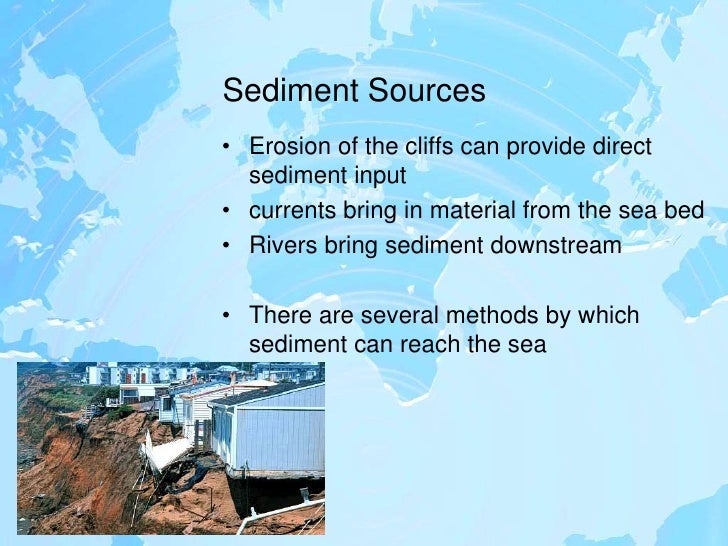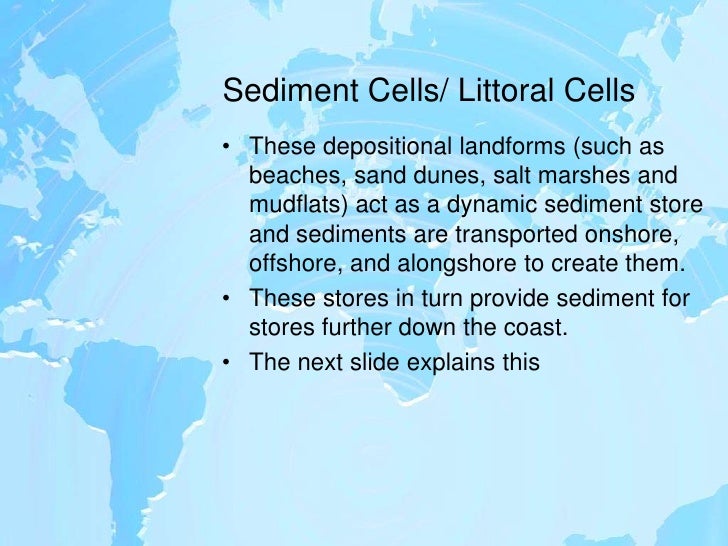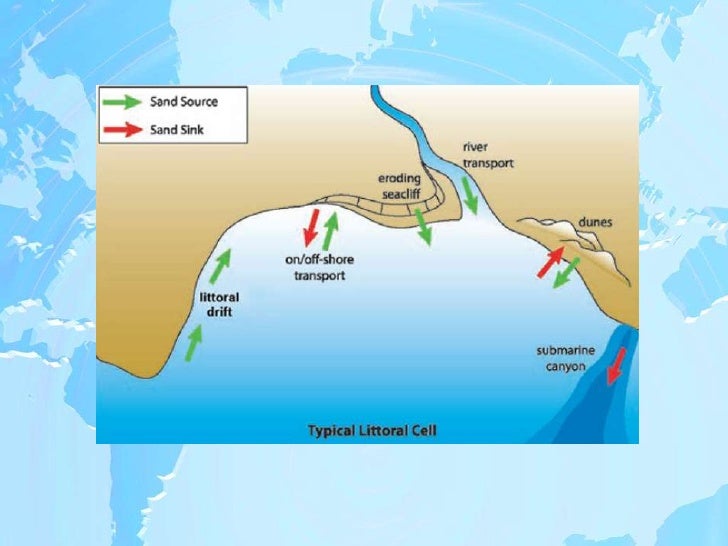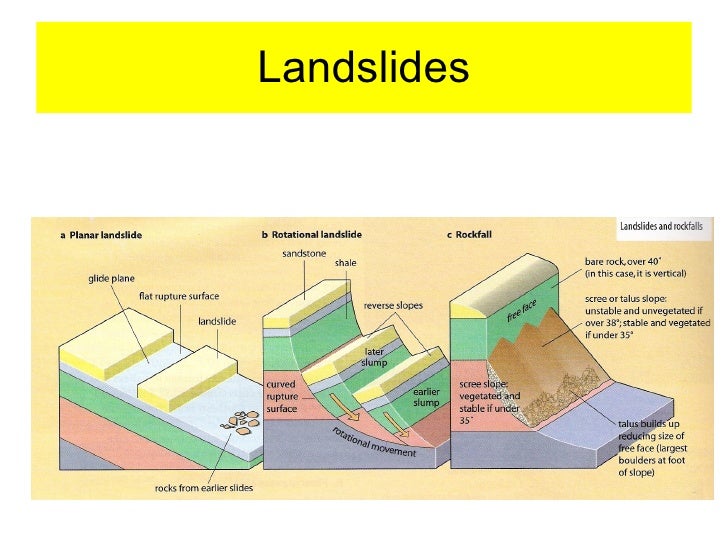Physical influences on coastal landscapes
The four ways that waves and tides erode the coast are described below:- Hydraulic action: Air becomes trapped in joints and cracks in the cliff face. When a wave breaks, the trapped air is compressed which weakens the cliff and causes erosion.
- Abrasion: Bits of rock and sand in waves are flung against the cliff face. Over time they grind down cliff surfaces like sandpaper.
- Attrition: Waves smash rocks and pebbles on the shore into each other, and they break and become smaller and smoother.
- Solution: Weak acids contained in sea water will dissolve some types of rock such as chalk or limestone.
- Solution: Minerals are dissolved in sea water and carried in solution. The load is not visible. Load can come from cliffs made from chalk or limestone, and calcium carbonate is carried along in solution.
- Suspension: Small particles are carried in water, eg silts and clays, which can make the water look cloudy: Currents pick up large amounts of sediment in suspension during a storm, when strong winds generate high energy waves.
- Saltation: Load is bounced along the sea bed, eg small pieces of shingle or large sand grains. Currents cannot keep the larger and heavier sediment afloat for long periods.
- Traction: Pebbles and larger sediment are rolled along the sea bed.
Waves
Waves are most commonly caused by wind. Wind-driven waves, or surface waves, are created by the friction between wind and surface water. As wind blows across the surface of the ocean or a lake, the continual disturbance creates a wave crest. These types of waves are found globally across the open ocean and along the coast.
More potentially hazardous waves can be caused by severe weather, like a hurricane. The strong winds and pressure from this type of severe storm causes storm surge, a series of long waves that are created far from shore in deeper water and intensify as they move closer to land. Other hazardous waves can be caused by underwater disturbances that displace large amounts of water quickly such as earthquakes, landslides, or volcanic eruptions. These very long waves are called tsunamis. Storm surge and tsunamis are not the types of waves you imagine crashing down on the shore. These waves roll upon the shore like a massive sea level rise and can reach far distances inland.
The gravitational pull of the sun and moon on the earth also causes waves. These waves are tides or, in other words, tidal waves. It is a common misconception that a tidal wave is also a tsunami. The cause of tsunamis are not related to tide information at all but can occur in any tidal state.

Constructive and Destructive Waves
When the swash is bigger than backwash material gets pushed up and accumulated on the beaches rather than removed. This gives a gentle beach profile. These waves are called CONSTRUCTIVE waves, and these waves tend to have low waves heights, lower wave frequencies (they break less often) and the waves are less steep. These waves are created by storms far out to sea which create a large swell which eventually reaches the coast.
Where backwash is larger than swash more material is being eroded from the beach profile than is being accumulated. This carries material out to sea and makes for a steeper beach profile. These waves are called DESTRUCTIVE WAVES which have steeper profiles, larger and higher wave crests and come more frequently.
Tides
How Do Tides Work?
Longshore drift
Longshore drift occurs as a result of wave action. Waves approaching the shore carry lots of energy. As these waves approach the beach, the base of the wave collides with the seabed. As a result, the waves topple and break apart.
In the process, they pick up sediment The sea bed determines what size particles will be picked up by the waves. Particle size is also determined by the force of the wave and how powerful it is. Once the wave approaches the shore, sediment is carried up the shore in angles by the waves. This is known as swash.
The wave then recedes back down the beach at an angle perpendicular (90 degrees) to the shore. This is known as backwash and as the wave backwashes, it carries sediment back down. Backwash occurs due to gravity and the resulting waves follow a different path down the beach as compared to when on their way up.
The entire process occurs in a somewhat zig-zag pattern. Material transported down the shoreline is carried by weak currents, known as longshore currents, that are produced as a result of the breaking waves.
The direction of the waves is dependent on the prevailing winds. The winds determine what path the waves will take and how the material will be swashed as well as back washed along the shore.
For example, if the winds are traveling in a north-west direction, then the waves will follow the same path picking up the sediment from the north-west and transporting it down the shoreline. Littoral drift is responsible for the formation of many natural features such as spits, barriers and tidal inlets. Let us briefly look at how these features are formed as a result.
Sediment cells



Lithology
Lithology refers to the physical properties of a rock such as its resistance to erosion. The lithology of a coastline affects how quickly it’s eroded. Hard rocks (e.g., Gabbro) are resistant to weathering & erosion so a coastline made of granite (e.g., Land’s End) will change slowly. Soft rocks (e.g., Limestone) are more susceptible to weathering & erosion so a coastline made of chalk (e.g., Dorset) will change relatively quickly.
If you looked down on a coastline from above and saw the geology of the area, you’d be able to see that the rock type changes as you approach the coastline and that the different rocks are arranged in bands. The angle these bands make with the coastline makes it either a concordant or discordant coastline.
Concordant coasts have alternating layers of hard and soft rock that run parallel to the coast. The hard rock acts as a protective barrier to the softer rock behind it preventing erosion. If the hard rock is breached though, the softer rock is exposed and a cove can form (e.g., Lulworth Cove).

On a discordant coastline, alternating layers of hard and soft rock are perpendicular to the coast. Because the soft rock is exposed, it is eroded faster than the hard rock. This differential erosion creates headlands and bays along discordant coastlines.

Subaerial processes
Sub-aerial processes refer to the processes of weathering and mass movement. Weathering is the breaking down of rock in situ. It can be divided into mechanical and chemical weathering.
Mechanical weathering refers to physical processes like freeze-thaw action and biological weathering. Freeze-thaw weathering breaks up rock as water freezes in cracks. The ice applies pressure and breaks the rock. Biological weathering is caused by the roots of vegetation and nesting birds. A more common type of mechanical weathering found at coasts is salt crystallization. This occurs as waves deposit salt crystals in cracks and over time the salt like ice applies pressure to the crack. Chemical weathering occurs as a result of a weak chemical reaction between water and rock. eg. with limestone. Carbonic acid, formed from rainwater and carbon dioxide, will react with calcium carbonate in limestone to form calcium bicarbonate. Since calcium bicarbonate is soluble in water, the limestone effectively gets weathered when carbonation occurs. The role of weathering is to weaken cliffs. This weakening speeds up the rates of erosion.
Another sub-aerial process is mass movement. A mass movement refers to the movement of material downslope under the influence of gravity. They can be rapid events, such as landslides and rockfalls or they can be slow processes, such as soil creep. A common type of mass movement at coasts are rotational slumps. Slumps occur due to a combination of factors. Marine processes erode and undermine the base of the cliff. This removes the support of the cliff. In addition rainfall infiltrates into the slope through unconsolidated porous material and then creates a slip plane as it reaches an impermeable material, such as clay. The clay and accumulating water enables the weighted saturated material above to slump.

Features of coastal erosion
Cliffs and wave-cut platforms
Cliffs and Wave-cut platforms


Stacks

Features of coastal deposition
Spit and beaches
How Coastal Spits are formed - labelled diagram and explanation
Source: http://www.travelsupermarket.com/blog/wp-content/uploads/2010/10/Farewell_spit-golden-bay-nz.jpg
Eustatic and isostatic movements
Eustatic Change
Eustatic change is when the sea level changes due to an alteration in the volume of water in the oceans or, alternatively, a change in the shape of an ocean basin and hence a change in the amount of water the sea can hold. Eustatic change is always a global effect.
During and after an ice age, eustatic change takes place. At the beginning of an ice age, the temperature falls and water is frozen and stored in glaciers inland, suspending the hydrological cycle. This results in water being taken out of the sea but not being put back in leading to an overall fall in sea level. Conversely, as an ice age ends, the temperature begins to rise and so the water stored in the glaciers will reenter the hydrological cycle and the sea will be replenished, increasing the sea levels.
Increases in temperature outside of an ice age will also effect the sea level since an increasing temperature will cause the ice sheets to melt, putting more water in the sea.
The shape of the ocean basins can change due to tectonic movement. If the ocean basins become larger, the volume of the oceans becomes larger but the overall sea level will fall since there’s the same amount of water in the ocean. Conversely, if the ocean basins get smaller, the volume of the oceans decreases and the sea level rises accordingly.
Isostatic Change
Isostatic sea level change is the result of an increase or decrease in the height of the land. When the height of the land increases, the sea level falls and when the height of the land decreases the sea level rises. Isostatic change is a local sea level change whereas eustatic change is a global sea level change.
During an ice age, isostatic change is caused by the build up of ice on the land. As water is stored on the land in glaciers, the weight of the land increases and the land sinks slightly, causing the sea level to rise slightly. This is referred to as compression. When the ice melts at the end of an ice age, the land begins to rise up again and the sea level falls. This is referred to decompression or isostatic rebound. Isostatic rebound takes place incredibly slowly and to this day, isostatic rebounding is still taking place from the last ice age.
Isostatic sea level change can also be caused by tectonic uplift or depression. As this only takes place along plate boundaries, this sort of isostatic change only takes place in certain areas of the world.
Advancing or retreating coasts and associated landforms
Source: Waugh (2000) Geography: An Integrated Approach
Raised beaches
Relict cliff
Fjord (U-shaped valleys)
Source: http://www.pinsdaddy.com/fjord-formation-diagram_nVY4vj7Qndek3TzEGD2NrXCNyz1rHsaoRTZ4LSHyE3k/
Sand dunes
How are Sand Dunes formed on a coast? - Labelled diagram and explanation
